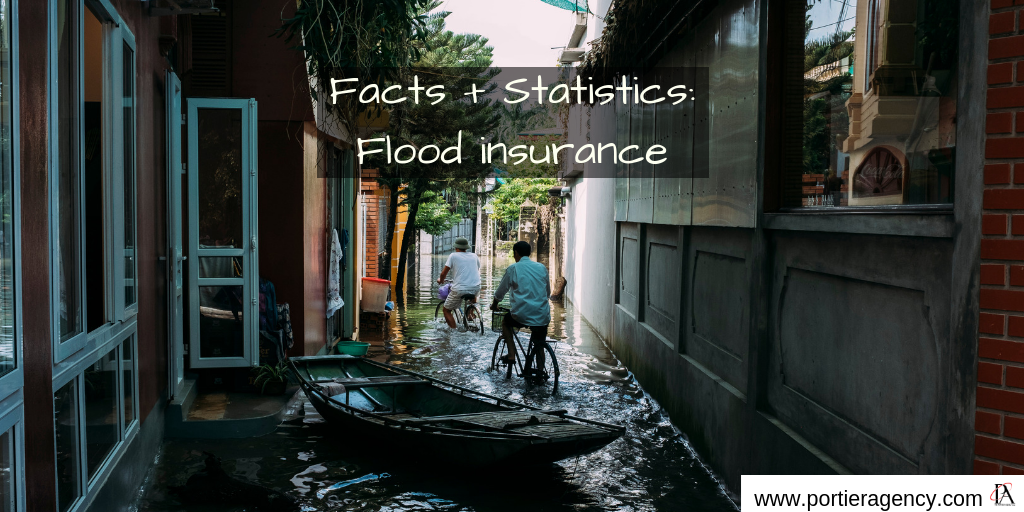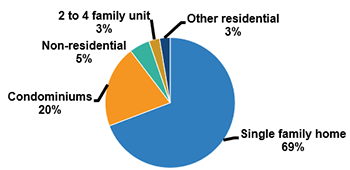Facts + Statistics: Flood insurance

Facts + Statistics: Flood insurance
National Flood Insurance Program
| Flood damage is excluded under standard homeowners and renters insurance policies. However, flood coverage is available in the form of a separate policy both from the National Flood Insurance Program (NFIP) and from some private insurers.
Congress created the NFIP in 1968 in response to the rising cost of taxpayer-funded disaster relief for flood victims and the increasing amount of damage caused by floods. The NFIP makes federally backed flood insurance available in communities that agree to adopt and enforce floodplain management ordinances to reduce future flood damage. The NFIP is self-supporting for the average historical loss year. This means that unless there is a widespread disaster, operating expenses and flood insurance claims are financed through premiums collected. The NFIP provides coverage for up to $250,000 for the structure of the home and up to $100,000 for personal possessions. Private flood insurance is available for those who need additional insurance protection, known as excess coverage, over and above the basic policy or for people whose communities do not participate in the NFIP. Some insurers have introduced special policies for high-value properties. These policies may cover homes in noncoastal areas and/or provide enhancements to traditional flood coverage. The comprehensive portion of an auto insurance policy includes coverage for flood damage. In 2016 the National Flood Insurance Program (NFIP) put a reinsurance program in place to better manage the losses it incurred from major events by transferring exposure to reinsurers. In January 2017 FEMA transferred $1.02 billion of the NFIP’s financial risk to 25 reinsurers. The NFIP recovered the entire $1.02 billion based on Hurricane Harvey flood losses. The NFIP returned to the private reinsurance market in 2018, paying $235 million for $1.458 billion in coverage from a single flood event from 28 reinsurers. The structure of 2018’s reinsurance changed from 2017, when reinsurers covered 26 percent of the $4 billion in losses after NFIP retained the first $4 billion in losses. For 2018 losses reinsurers will pay 18.6 percent of the first $2 billion of losses in excess of $4 billion and 54.3 percent of the next $2 billion in excess of $6 billion, up to a maximum of $1.46 billion. In both 2017 and 2018 the NFIP got no protection for the first $4 billion of any flood event. In January 2019 the NFIP obtained $1.32 billion in reinsurance from 28 carriers, slightly less than the $1.46 billion obtained in 2018. The reinsurance would cover losses above $4 billion from a single event, at a premium cost of $186 million. The reinsurance program would cover 14 percent of losses between $4 billion to $6 billion; 25.6 percent of losses between $6 billion and $8 billion; and 26.6 percent of losses between $8 billion and $10 billion. As of April 2019, FEMA has secured $800 million of additional funds from catastrophes bonds. In August 2018 FEMA launched its first catastrophe bond to transfer risk from the NFIP to the capital markets. It was the first catastrophe bond to provide reinsurance coverage solely for flood risks. FEMA obtained $500 million of reinsurance protection from the FloodSmart Re Ltd. (Series 2018-1 issuance). The transaction, from FloodSmart Re, which is a Bermuda domiciled special purpose insurance vehicle, will cover NFIP losses from flood events that are directly or indirectly caused by a named storm event impacting the United States including Puerto Rico, the U.S. Virgin Islands and the District of Columbia. In March 2019, FEMA secured a second catastrophe bond seeking $300 million from the FloodSmart Re Ltd. Series 2019-1. The program will extend over three years and the terms are identical to the August 2018 catastrophe bond deal. According to Artemis, the latest catastrophe bond brings total capital markets backed reinsurance coverage to $800 million. When added to traditional reinsurance purchased in January 2019, this brings NFIP protection to $2.12 billion for the 2019 named storm and hurricane season. Congress must periodically renew the NFIP’s statutory authority to operate. In the unlikely event the NFIP’s authorization lapses, claims would still be paid but the NFIP would stop selling and renewing policies (more details here.) On March 18, 2019 the Trump administration announced plans to reform the NFIP with a shift to fully risk based pricing of flood insurance. FEMA said the programwould begin to assess properties individually, using several variables such as hurricane rainfall, coastal surges and proximity to bodies of water, rather than applying a single formula for an entire flood zone. FEMA’s current system calculates rates based on whether a home falls in a designated flood zone, and since higher-valued properties are more likely to hit the $250,000 insurance cap, lower-value homes are paying proportionately more than higher-value homes. The reformed system would change that as well as potentially drive more flood risk into private reinsurance and risk markets. FEMA will announce the new rates on April 1, 2020, and it will implement the new system on October 1, 2020. The 2018 Insurance Information Institute Pulse survey found that 15 percent of American homeowners had a flood insurance policy, up from 12 percent who had the coverage in 2016, as shown in the following chart. |
|
National Flood Insurance Program Policies By State, 2017 (1)
|
|||||||||||||||||||||||||||||||||||||||||||||||||||||||||||||||||||||||||||||||||||||||||||||||||||||||||||||||||||||||||||||||||||||||||||||||||||||||||||||||||||||||||||||||||||||||||||||||||||||||||||||||||||||||||||||||||||||||||||||||||||||||||||||||||||||||||||||||||||||||||||||||||||||||||||||||||||||||||||||||||||||||||||||||||||||||||||||||||||||||||||||||||||||||||||||||||||||||||||||||
(1) Direct and Write-Your-Own (WYO) business may not add to total due to rounding.
(2) Total limits of liability for all policies in force.
(3) Includes WYO policies written in unknown areas.
Source: U.S. Department of Homeland Security, Federal Emergency Management Agency.
Flood Insurance Policies In Force By Occupancy Type, 2018 (1)

(1) As of July 31, 2018.
Source: Federal Emergency Management Agency (FEMA).
Two events that occurred in 2017 gained places in the chart below showing the 10 most significant floods based on National Flood Insurance Program (NFIP) payouts as of October 31, 2018. Hurricane Harvey ranks as the second most significant U.S. flood event, with about 76,000 NFIP policyholders filing claims. FEMA has paid $8.9 billion to those policyholders. Flooding from Hurricane Irma ranks at number 9, with about 22,000 policyholders filing claims, and $1 billion in payments. Hurricane Florence, which occurred in September 2018, ranked 23rd with about 9,000 claims filed and about $335 million in payouts. The figures below are preliminary, as claims are still being processed, and […]
# # #
Continue to read this Insurance Information Institute article.
Don’t forget, The Portier Agency offers:
homeowner/mobile home/ renter’s /automobile / motorcycle / life / commercial / crop insurance.
Call or come by to get your quote!
 The Portier Agency, LLC
The Portier Agency, LLC
113 North Irwin Avenue
Ocilla, GA 31774
229-468-3444
portieragency@windstream.net